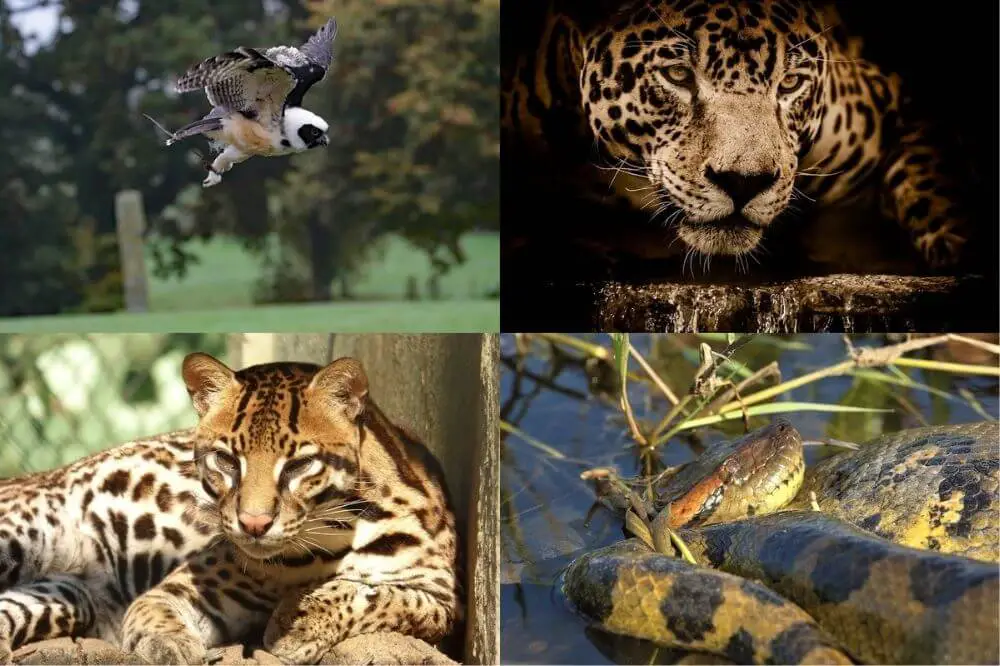
We know that sloths are solitary creatures, and mostly tend to live high up in rainforests. But do sloths have predators, and if so how exactly do they go about hunting their prey? I wanted to find out the answers to these questions, so I did some research, and was very surprised with what I found…
So do sloths have predators? Yes sloths do have predators. They can be hunted from the skies by harpy eagles, crested eagles and spectacled owls. They are hunted by big cats such as jaguars, ocelots and margays. In water they can be killed by anacondas. Humans also hunt sloths to keep them as pets, for food or for trophies.
So the answer to the question do sloths have predators is a very definite yes. Let’s take a closer look at which of the predators hunts each of the different sloths, and a bit more about exactly how they go about stalking and killing sloths.
Contents
Do Sloths Have Predators?
So yes, sloths do have predators. To answer this question fully we are going to need to look at each of the different types of sloths. Until I started researching sloths further for this site, I thought there was just one type and that was it.
I was totally wrong. It turns out there are actually 6 species of sloths, split between two larger groups called genera (the plural of genus). These genera of sloths are the two-toed sloth and the three-toed sloth. There are many differences between these two types of sloths.
The two-toed sloth, or to give its scientific name, the Choloepus, is a member of the Choloepodidae family. It is split into a further two species. These are:
- Choloepus didactylus (Linnaeus’s two-toed sloth)
- Choloepus hoffmanni (Hoffmann’s two-toed sloth)
The three-toed sloth, known scientifically as the Bradypus, from the family Bradypodidae, is split into a further 4 species of sloths. These are:
- Bradypus torquatus (Maned sloth)
- Bradypus tridactylus (Pale-throated sloth)
- Bradypus variegatus (Brown-throated sloth)
- Bradypus pygmaeus (Pygmy three-toed sloth)
Now we know a little bit about the organisation of sloths and their names, we need to take a look at some more information about them, such as where they live and what they like to eat. This will help us when answering the question do sloths have predators.
Linnaeus’s Two-Toed Sloth
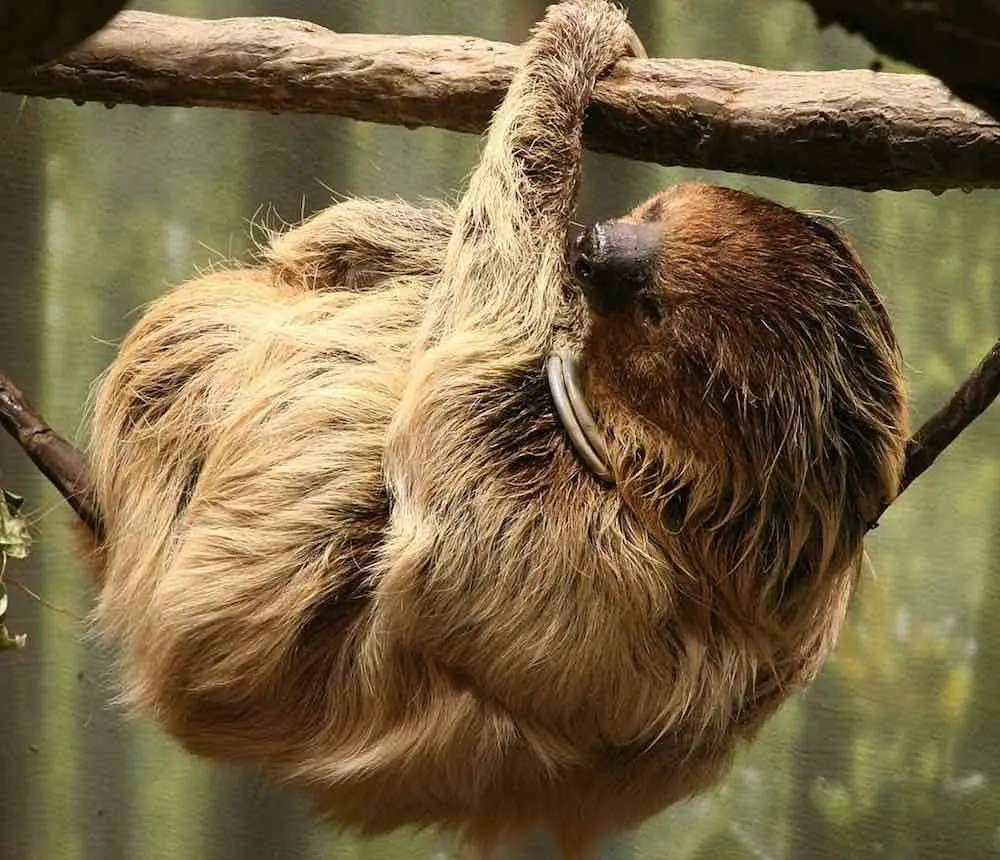
The Linnaeus’s two-toed sloth is also sometimes called the southern two-toed sloth. Its scientific name is Choloepus didactylus.
It was first discovered or at least written about by the Swedish Botanist Carl Linnaeus. As you will see further on in this article, this is not the only animal that he was the first person to write about.
Like most of the other sloths we will talk about, the Linnaeus’s sloth spends almost all of its time hanging in trees and sleeping. It sleeps between 15 and 20 hours a day.
It is native to parts of South America, and can be found in:
- Brazil
- Bolivia
- Columbia
- Ecuador
- Guyana
- Peru
Like the other sloths, this one is mostly a herbivore. It gets almost all of the food it needs from the tress it lives in, eating mostly leaves, along with some berries and fruits. This is one of the reasons the rainforest is an ideal place for sloths to live.
This can actually be good for the environment sloths live in, pruning trees and allowing some sunlight into the rainforest.
Animals that prey on the Linnaeus’s two toed sloth include big cats such as jaguars and ocelots. They can also be preyed upon by birds such as harpy eagles and crested eagles.
Now sloths can swim, and do spend some time in the water. Here they are in danger of being eaten by water dwelling snakes such as anacondas.
Hoffmann’s Two-toed Sloth
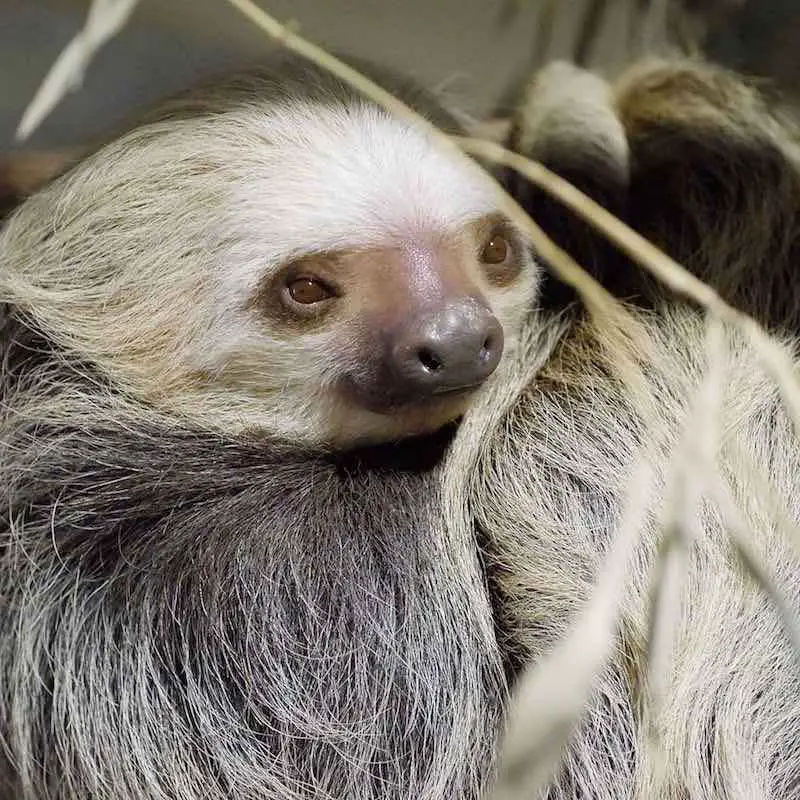
The Hoffman’s two-toed sloth was first discovered by the german naturalist Karl Hoffmann. Its species name is Choloepus hoffmanni, for obvious reasons. There are actually five recognised subspecies of this type of sloth. These are:
- Choloepus hoffmanni hoffmanni
- Choloepus hoffmanni agustinus
- Choloepus hoffmanni capitalis
- Choloepus hoffmanni juruanus
- Choloepus hoffmanni pallescens
The Hoffman’s two-toed sloth lives in tropical rainforests in Central and South America. They live specifically in:
- Brazil
- Bolivia
- Ecuador
- Honduras
- Peru
The Hoffman’s two-toed sloth is also arboreal, spending almost all of its time in trees. Here it easts mostly leaves, as well as some berries and flowers.
Sloth predators for the Hoffman’s two-toed sloth again include big cats such as jaguars, margays and ocelots. They are also hunted by the harpy eagle. The Hoffman’s two-toed sloth is also sadly often hunted by humans.
Again the water is not a safe place for this type of sloth, as it can easily be caught by the anaconda, a deadly sloth predator.
Maned Sloth
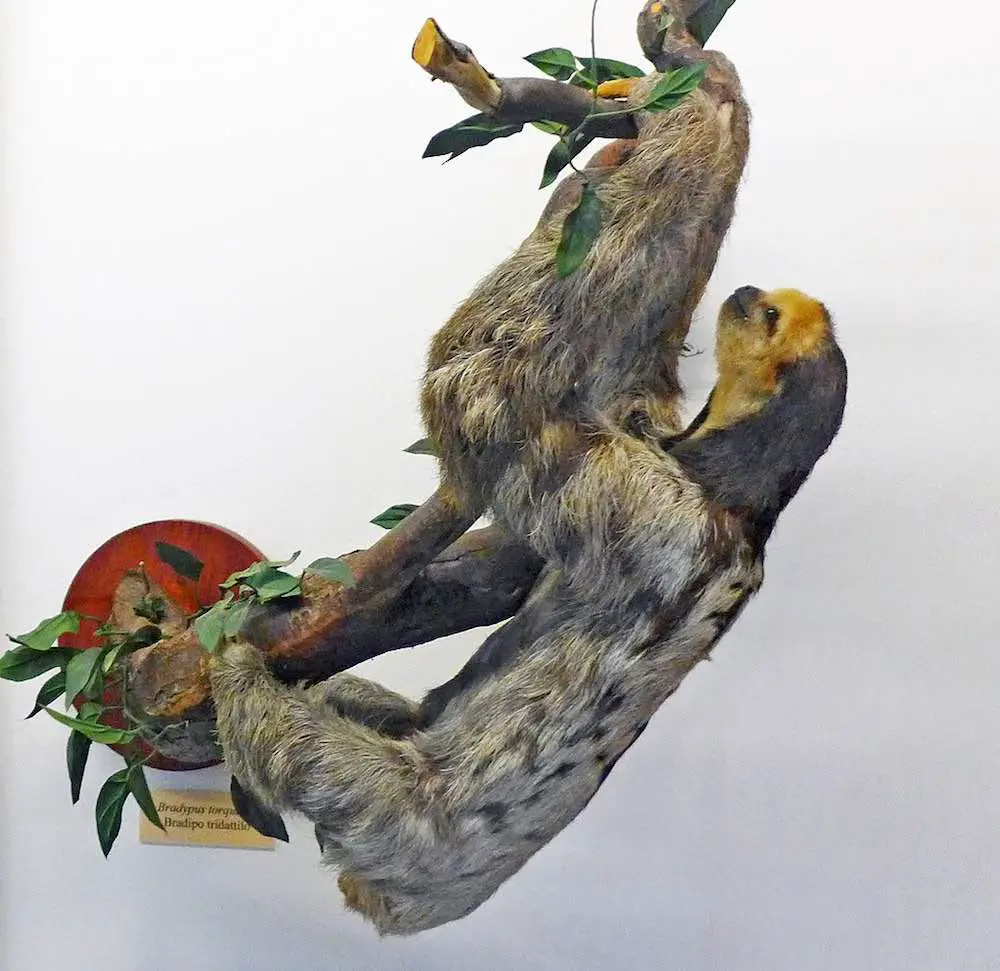
The maned sloth is a member of the three-toed sloth family. Its scientific name is Bradypus torquatus.
This type of sloth is diurnal, which means that some of its awake time will be during the day. Having said that, due to the amount of time it sleeps, it really won’t be about much during the day anyway.
The maned sloth is really only native to one place. This is in the Atlantic rainforest of Southeastern Brazil. Like all of the other sloths, most of its diet is taken up by eating leaves. For this type of sloth, really young leaves are the easiest for it to digest.
Animals known to prey on the maned sloth are jaguars, ocelots, leopards and harpy eagles.
Pale-Throated Sloth
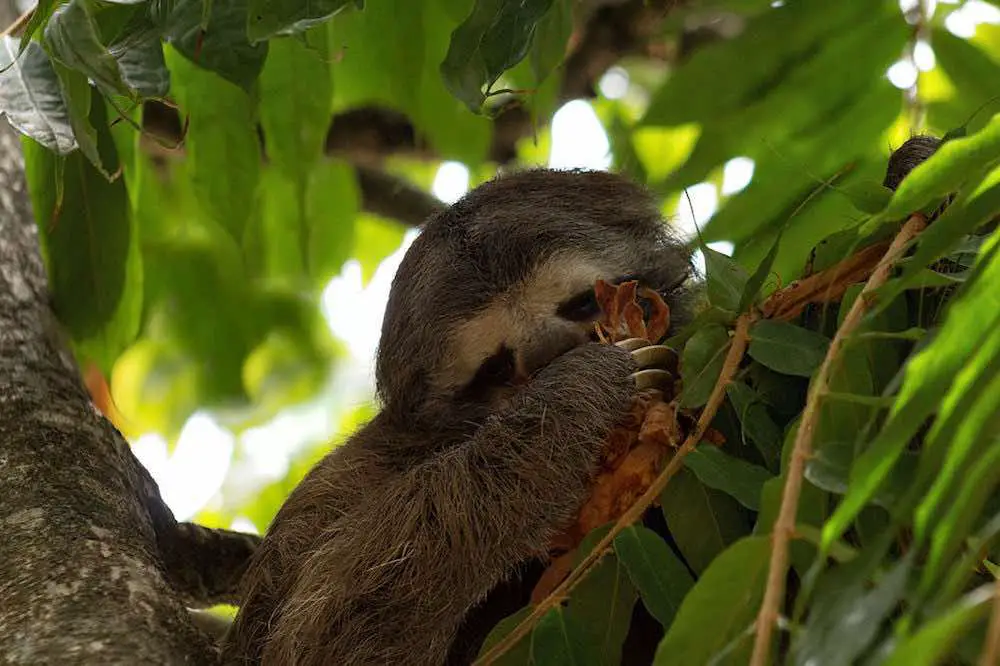
The pale-throated sloth is also a member of the three-toed sloth family or genus. Its scientific name is Bradypus tridactylus. It gets its name from the pale patch of fur around its throat.
The maned sloth is native to the rainforest of Northern South America. You will find them in:
- Brazil
- French Guiana
- Guyana
- Suriname Venezuela
Again they like to eat leaves, and their diet is mostly made up of these. In particular they like to eat leaves from cecropia trees.
In their natural habitat, animals that prey on the pale-throated sloth include jaguars, ocelots, margays, eagles, anacondas and humans.
Brown Throated-Sloth
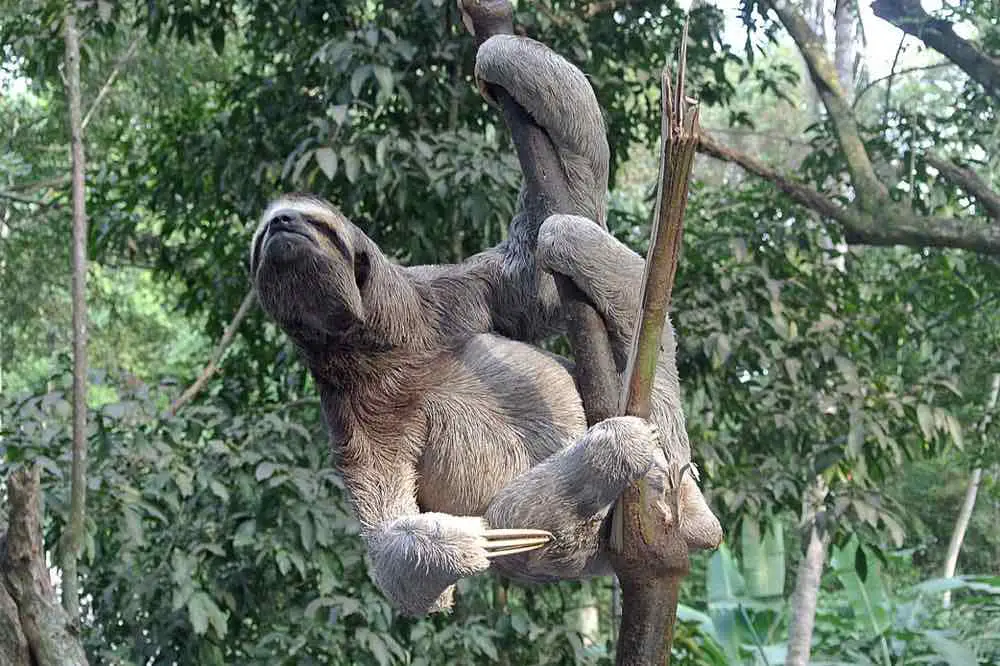
The brown-throated sloth is another member of the three-toed sloth family. Similar in nature to the pale-throated sloth, this one has a brown patch of fur around its throat area.
The scientific name for the brown-throated sloth is Bradypus variegatus. It was first discovered by Heinrich Rudolf Schinz in 1835. There are seven recognised subspecies of the brown-throated sloth. These are:
- Bradypus variegatus boliviensis
- Bradypus variegatus brasiliensis
- Bradypus variegatus ephippiger
- Bradypus variegatus gorgon
- Bradypus variegatus infuscatus
- Bradypus variegatus trivittatus
- Bradypus variegatus variegatus
The brown throated sloth lives in the Neotropical area of Central and South America. It is the most common sloth, and can be found in the following countries:
- Brazil
- Bolivia
- Columbia
- Costa Rica
- Ecuador
- Honduras
- Nicaragua
- Panama
- Peru
- Venezuela
In these countries it is preyed upon mostly by jaguars, spectacled owls and harpy eagles.
Pygmy Three-Toed Sloth
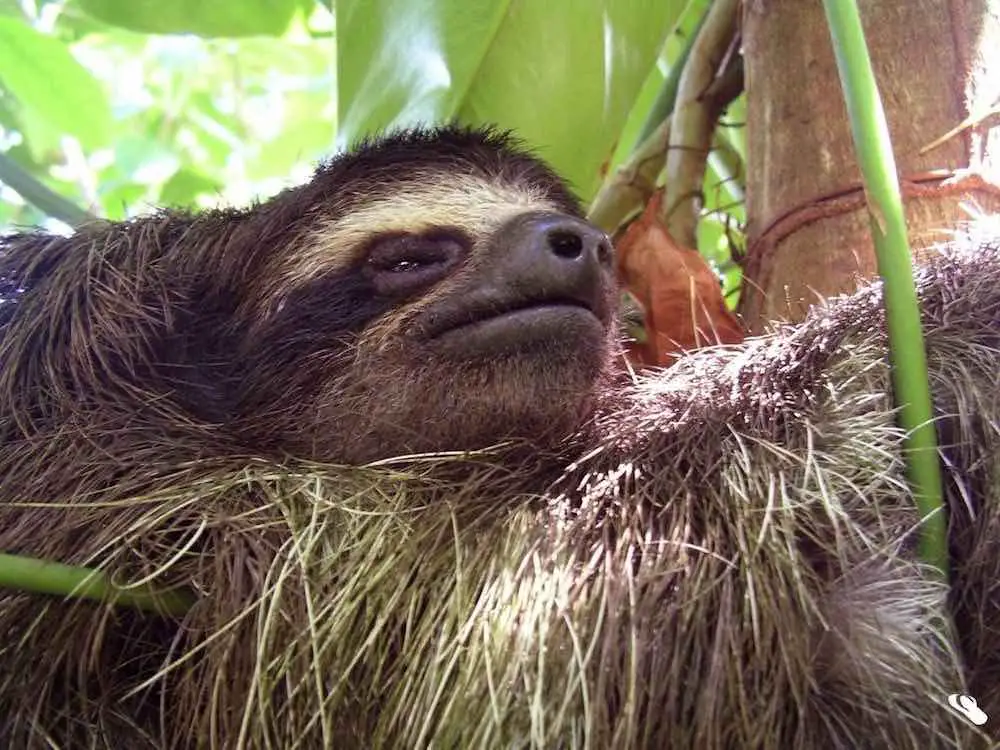
The pygmy-three toed sloth is the last of the sloths we will look at in answering the question do sloths have predators. Its scientific name is Bradypus pygmaeus, for obvious reasons.
The pygmy-three toed sloth is also sometimes referred to as the monk sloth and the dwarf sloth. Again this is mostly because of its size.
This type of sloth was only discovered as as species in 2001 by Robert P. Anderson a professor of biology, and Charles O. Hanley Jr. of the Smithsonian Institute.
In direct contrast to the brown-throated sloth above, the pygmy three-toed sloth is the rarest sloth left in existence. There are thought to be less than 100 of these types of sloths left in existence today.
It is known to only live in one very specific area. This is in a place known as Isla Escudo de Veraguas, an Island just off the coast of Panama.
In terms of predators, there seems to be no known animals that prey on the pygmy-three toed sloth, other than humans. Whilst it is illegal to hunt this type of sloth, many still do.
They can be captured and taken as pets when they are young, or to live in zoos for people to see.
Sloth Predators
So we have read a little bit about the where each of the different sloths live, and exactly which animals prey on them in their natural environments.
To answer the question do sloths have predators more fully, let’s take a closer look at these animals.
Jaguars Are Well Known Sloth Predators
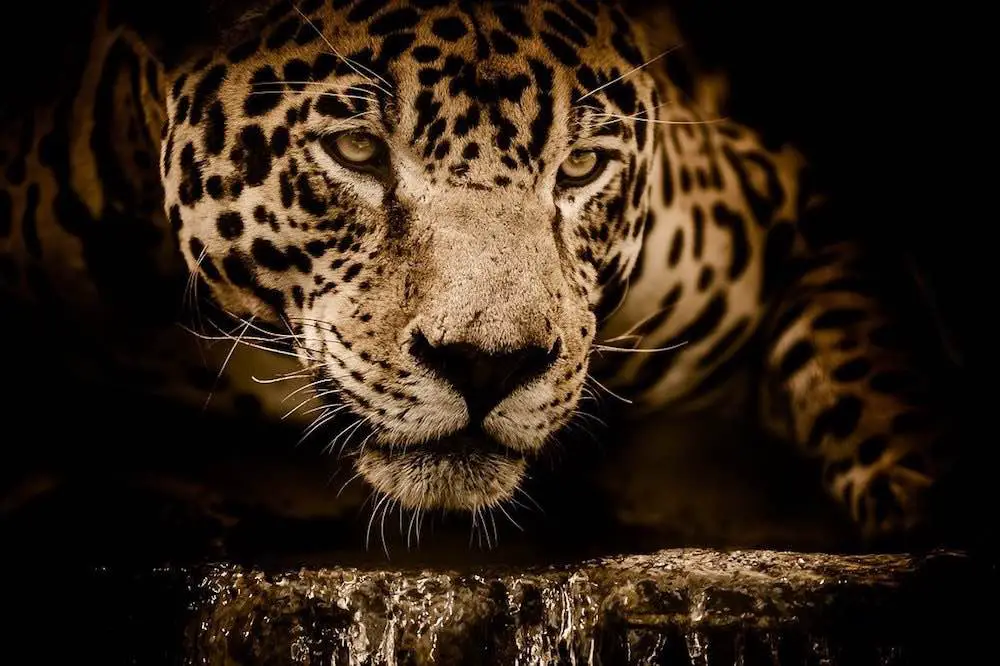
The first of the animals that prey on sloths for us to look at is the jaguar. This is known to prey on many of the different breeds of sloths. The jaguars species name is Panthera onca, and it is the only extant member of the genus Panthera.
Interestingly the Jaguar was first described by Carl Linnaeus in his writing of Systema Naturae. This is the same Carl Linnaeus who also discovered and described the Linnaeus’s two-toed sloth.
In the 19th and 20th century more subspecies of the jaguar were observed, and there are now known to be nine recognised subspecies.
The jaguar is native to the Americas, and can be found in the following places:
- Amazon Rainforest in Brazil
- Bolivia
- Columbia
- Costa Rica
- Ecuador
- French Guyana
- Guatemala
- Guyana
- Honduras
- Nicaragua
- Panama
- Paraguay
- Peru
- Surinam
- United States
- Venezuela
The jaguar is known as an apex predator. This basically means you don’t want to mess with it, as it is at the top of the food chain.
It is also described as something known as a keystone species. this is because it helps to control herbivorous and granivorous mammals. By doing this it helps to maintain the ecosystem of rainforests.
So how exactly does a jaguar prey on sloths? Most of the big cats will hunt prey by chasing them down. They will either catch them due to their explosive speed and power, or keep hunting them until they become tired and slow down.
A jaguar is more cautious than this in its approach to hunting prey. It will move slowly and quietly, listening and watching for other animals to prey on. To be honest the most likely time and place a jaguar will catch a sloth is when it comes down from the trees for its weekly toilet ritual.
However, jaguars are excellent swimmers, well known for being able to kill and carry their prey in water. As we know sloths are good swimmers, and will often use rivers as corridors between forested areas. A jaguar could well prey on a sloth in the water.
Other animals that jaguars prey on include:
- Anteaters
- Armadillos
- Foxes
- Tapirs
- Livestock such as horses
Ocelots Can Prey On Sloths Too
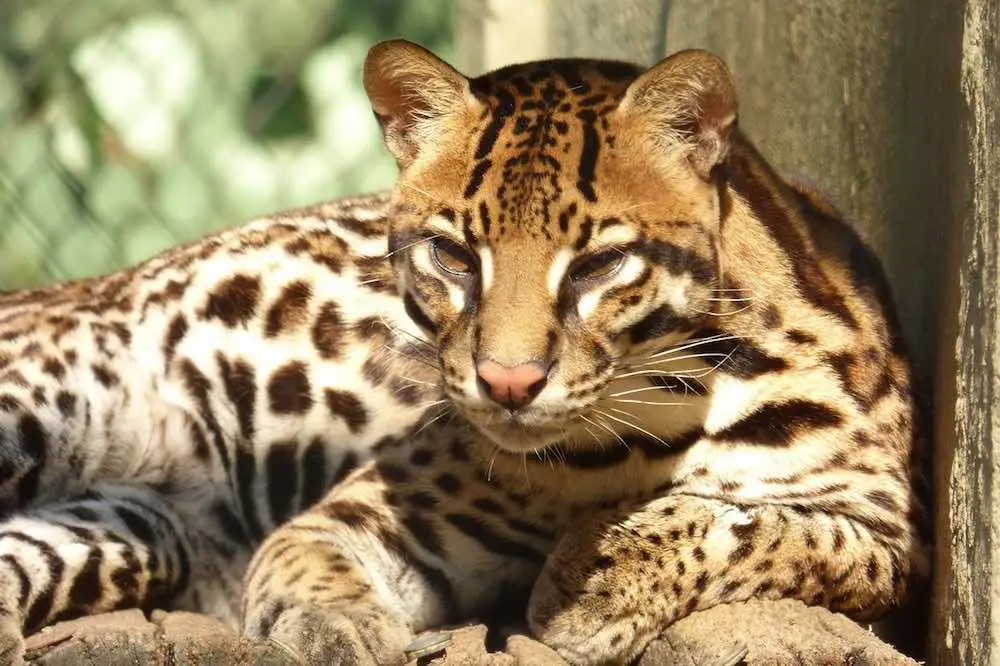
Ocelots are another member of the big cat family that regularly prey on sloths. Until I looked into some information for this post, I had literally never heard of an ocelot before. The scientific name for this type of animals is Leopardus pardalis.
Again this is another animal that was first described by Carl Linnaeus, in 1758. There are two recognised subspecies of ocelots.
Ocelots live in a variety of places, and can be found in:
- Central America
- South America
- Southwestern United States
- Margarita
- Trinidad
Ocelots like to hunt their prey at twilight and during the night. Like the leopard, they will stalk their prey slowly. In fact, they can wait up to an hour in one place for prey to reveal themselves.
Staying in one place and extremely still and quiet, they make it very difficult for their prey to detect their presence.
If they see a sloth on or close to the ground, they will very quickly pounce on them, taking them by surprise. A sloth has very little chance of defending themselves or escaping from this.
As well as preying on sloths, ocelots will also prey on:
- Armadillos
- Opossums
- Hares
- Rabbits
Margays Are Capable Of Climbing Trees To Prey On Sloths
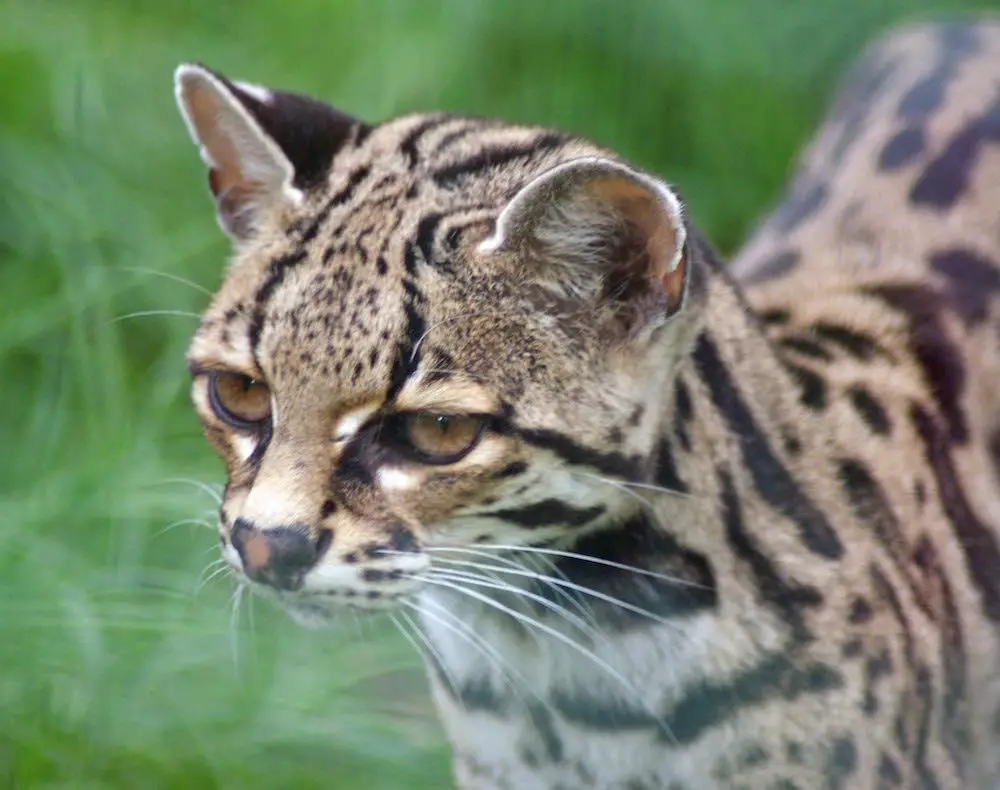
The margay is another member of the wild cat family know for hunting sloths. The margay is smaller than the jaguar and ocelot, although it does look reasonably similar to the ocelot.
Its scientific name is Leopardus wiedii. It can be found in many areas of both Central and South America.
Margays prefer to live in forested and evergreen areas. As many of their homes have been destroyed, and because they have been illegally hunted, their population is in an alarming rate of decline. For this reason they have been listed as Near Threatened by the IUCN on their Red List.
In terms of hunting, the margay is a very skilled tree climber. Bad news for sloths right? Sloths stay safe from predators by hiding high up in the canopies of the rainforests.
Just when you think you are safe up in the canopy along comes a skilled climber like the margay.
So they can be under attack from above with some of the birds that swoop down, and from below by margays who can climb up to grab them.
Although there is evidence of margays hunting and killing sloths, they normally do prey on smaller mammals, including:
- Birds
- Eggs
- Guinea Pigs
- Lizards
- Monkeys
- Rats
- Tree Frogs
Harpy Eagles Are Sloth Predators From The Sky
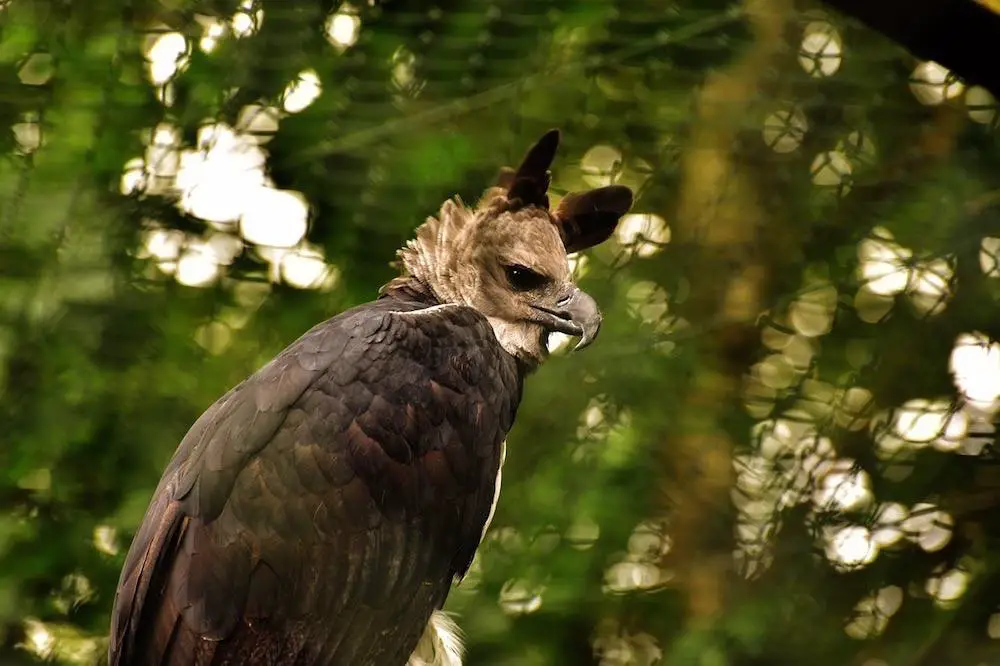
Harpy eagles are a neotropical species of eagle, also sometimes known as the American harpy eagle. Its scientific name is harpia harpyja. It is the largest and most powerful of the raptors found living in rainforests.
They can be found in many areas of Central and South America. Unfortunately for sloths they tend to live high up in the canopies of rainforests. The exact areas that many sloths also live and forage for food.
They will eat sloths and other tree dwelling animals such as monkeys. They have very long talons or claws, and can lift and carry animals that weight as much as they do.
When hunting they will fly from tree to tree, resting on branches and scanning to see what they can prey on. As soon as they see movement they will swoop in and grab their prey.
Crested Eagles Are Sloth Predators From The Sky Too
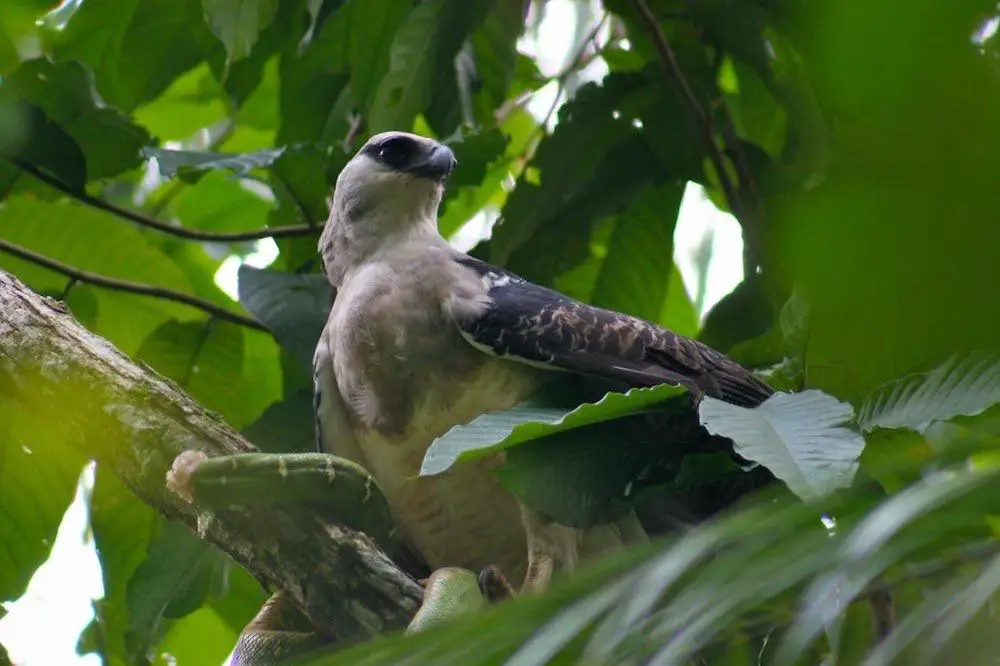
The crested eagle is another large member of the eagle family known for preying on sloths. Their scientific name is Morphnus guianensis. They can be found in:
- Argentina
- Belize
- Bolivia
- Brazil
- Columbia
- Ecuador
- French Guiana
- Guyana
- Paraguay
- Peru
- Suriname
- Venezuela
The crested eagle is a smaller bird than the harpy eagle. For this reason they will try to avoid hunting the same foods as the harpy eagle.
Instead they tend to prey on several types of monkeys, snakes and lizards. They are slow well known for preying on sloths too though.
Unfortunately for sloths, like the harpy eagle, the crested eagle also likes to live in the canopy of the rainforests, meaning they are also close to where sloths live.
Spectacled Owls Prey On Sloths In Trees
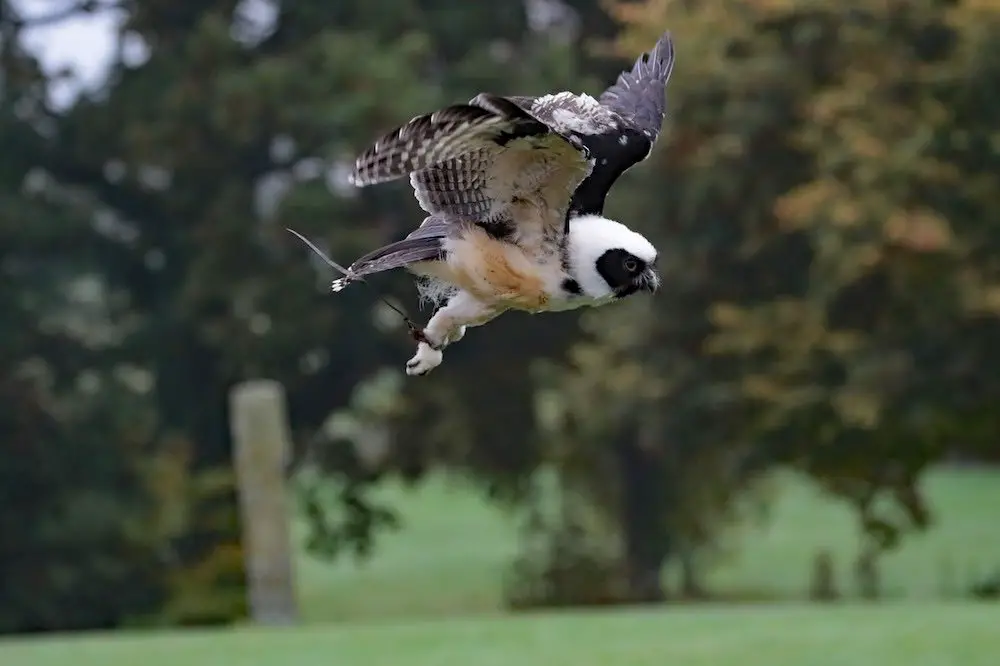
Spectacled owls are reasonably common, and can be found in a number of areas, including:
- Argentina
- Brazil
- Bolivia
- Central America
- French Guiana
- Guyana
- Honduras
- Mexico
- Paraguay
- Trinidad
- Venezuela
Their species name is Pulsatrix perspicillata, and there are six recognised subspecies. They live in forested areas, and like most owls are nocturnal.
Spectacled owls will come out at night to hunt their prey. They will sit high up on branches, swooping down to grab anything they see moving.
Whilst they do tend to prey on smaller animals, their is evidence of spectacled owls killing various members of the three-toed sloth family. They will also eat:
- Bats
- Frogs
- Large insects
- Rats
- Spiders
Anacondas Are Sloth Predators In The Water
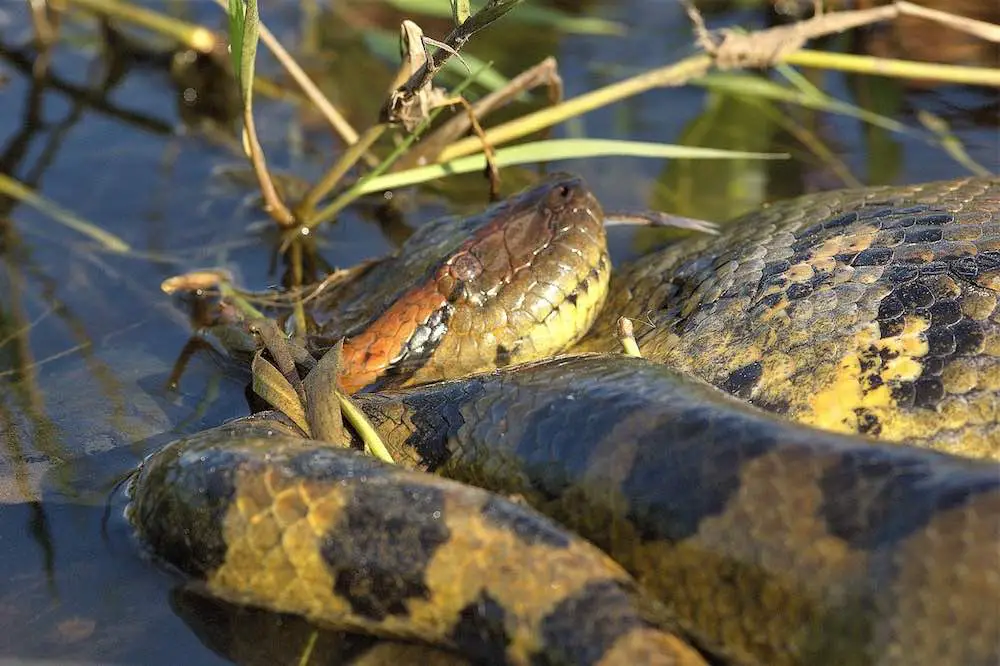
I remember when I was a kid watching that film Anaconda and being absolutely terrified of them. If I’m honest I was too young to watch it. Way below the legal age anyway, and at the time I thought they were completely made up creatures.
But anacondas are real, and they are killers for sure. They are also known as water boas, and come from the genus Eunectes.
The Eunectes genus is a collection of snakes known as water snakes. Anacondas live in the tropical rainforests of South America, and will be found in the rivers there.
There are four recognised subspecies of anacondas. The biggest of these is the green anaconda. It is the heaviest snake in the world, and the second longest, behind the reticulated python.
As we know sloths like to swim, and are actually quite good at it. They will be easy prey for any anaconda that comes across them in the water.
An anaconda is a constrictor. This means that they will coil their entire bodies around their prey until the animal is dead. If they get hold of a sloth in the water, there is next to no chance of them escaping death.
Humans Hunt Sloths Too
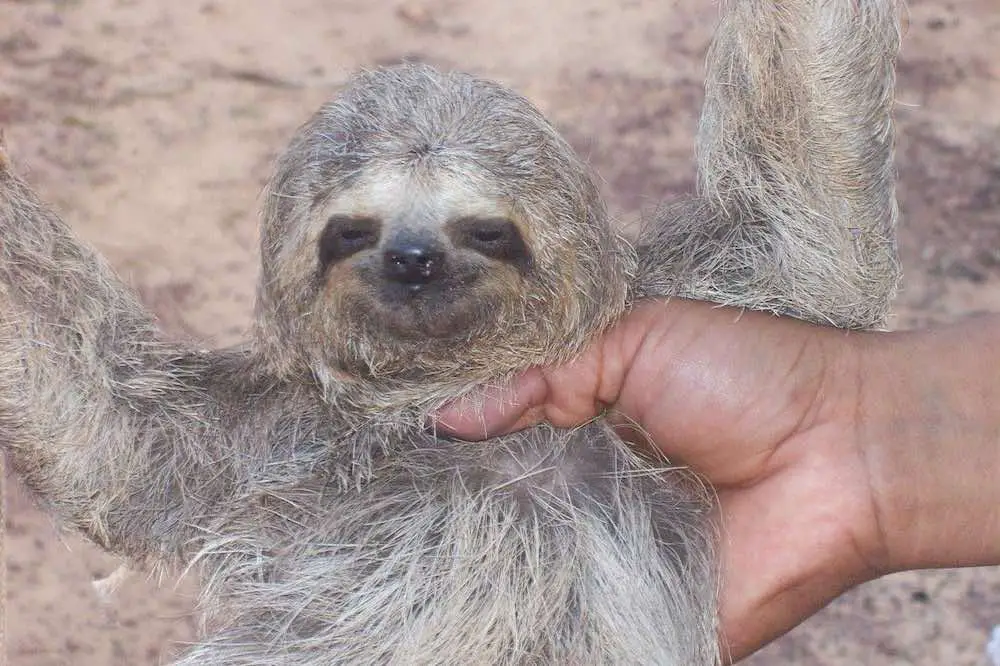
Believe it or not humans can also be classed as predators to sloths. This can be for a number of reasons. Many sloths are caught in their natural habitat to be sold as pets.
This is awful, as sloths would find it very difficult to survive outside of their natural environment. As herbivores, they have a very specific diet, which is hard to maintain if you keep one of these as a pet.
Sloths are also taken to be shown in zoos and other establishments such as this. Again, its really not great for the sloth. Animals are much better off in their natural environments where at all possible.
An even more awful reason that sloths are hunted by humans is as trophies. Can you believe that humans would take pride in being able to hunt such a slow animal?
Humans indigenous to some of the areas that sloths live may also hunt them as a source of food. Living off the land and eating what you can find, in many ways a sloth would make easy prey for a hunter such as this looking for food.
How Do Sloths Protect Themselves From Predators?
The main method a sloth has for protecting itself from predators is its ability to camouflage and stay still. Now sloths are not slow because they do this on purpose to hide.
They have an extremely slow metabolism, with some foods taking up to a month to be digested fully. Their heart rate is slow, as is pretty much everything else about them.
This slowness and inability to make sudden movements has its advantages. Sloths have a number of creatures living in their fur, and over time the sloth’s fur grows a green algae, which covers most of it.
This green algae, coupled with the fact that when sloths are in the trees they barely move, means it is very difficult and almost impossible for a predator to see them. High up in the canopy, they are fairly safe from the ground predators that they will encounter. This is a smart tactic!
The most dangerous time for a sloths is when it come down from the tress to go to the toilet. They only do this around once a week, and this is more than likely for a couple of reasons.
Firstly, because their metabolism is so slow, they do not need to go the bathroom as often as we do. I’ve been a teacher for many years, and believe me many teachers would kill for the ability to not go to the bathroom for days. Many of them don’t!
The second reason is that the journey down from the trees and then back up again is not the quickest, and takes a lot of the already small amount of energy a sloth has. While on the ground, unable to move quickly, they make easy prey for predators.
Will Sloths Attack If they Are Threatened?
I’ve written a whole other post that answers the question are sloths dangerous to humans, and it is useful to think about whether sloths will attack if they feel threatened.
Attack is a pretty strong word. Sloths are not going to go out of their way to chase another animal. They are herbivores, and don’t need to hunt animals for food.
However, if an animal was to try to eat a sloth, it is capable and willing to defend itself.
Sloths have extremely long claws, which are capable of doing some damage to animals and to humans too.
Should an animal or human get too close to a sloth, and if the sloth feels particularly threatened, it will take a swipe with these claws, and can do some damage for sure.
What Other Threats Are There To Sloths?
Sadly probably the biggest threat to sloths does not come in the form of predators. The destruction of its natural habitat means that there are less and less places for sloths to live. I guess this is the same for many of the rainforest animals.
Deforestation happens in many of the places natural to sloths, with wood being sold and land being used for cattle grazing.
Believe it or not cars are also a big danger to sloths. Many of the forests now have roads running through them where they did not exist before.
If a sloth is crossing the road and a car comes, believe me it is going to be extremely difficult for it to move out of the way.
Sloths are able to walk at around 4 meters per minute, which is extremely slow, and not quick enough to move out of the way of an oncoming vehicle.
Are Sloths Endangered?
Many of the sloths we have looked at are in danger of becoming extinct. In fact although there are 6 species of sloths alive today, there are many extinct species that are not around at all any more.
Of the 6 remaining species, some of these are in danger of joining them. In particular there is the pygmy three-toed sloth.
Due to the tiny living areas that this sloth inhabits (it inhabits an area approximately 4.3 square kilometres in area), it has been placed on the IUCN Red List for endangered species, and is classified as critically endangered.
Summing Up
So there you go. The answer to the question do sloths have predators is a definite yes. They can be hunted by members of the cat family such as jaguars, ocelots and margays. Margays can actually hunt them in tress, so they are not safe up high away from them.
They can also be attacked from above the canopy by eagles such as the harpy eagle and crested eagle, and by the spectacled owl.
As we can see, they are also not safe in the water, as they can be attacked here by water snakes such as the anaconda.
Unfortunately they can also hunted by humans. This can be for a number of reasons. They can be taken when they are young to be kept as pets or to be placed in zoos. They can also be hunted for trophies, and in some places for food too.
Thanks for reading this post about sloth predators. If you have anything to add, or would like to ask a question then please leave a comment below.

